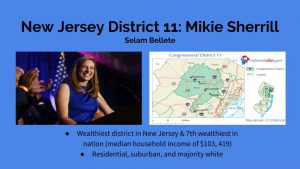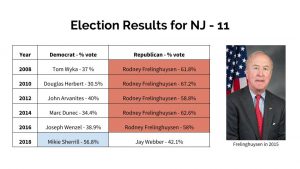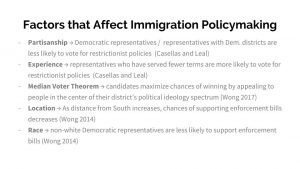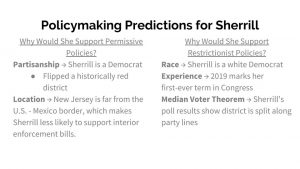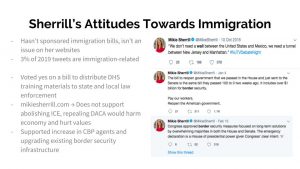Link to full presentation: https://docs.google.com/presentation/d/1rqiSn0HPYLn9JNr3HHCwDfhuVur5xX8pzL3EDXvSZXA/edit?usp=sharing
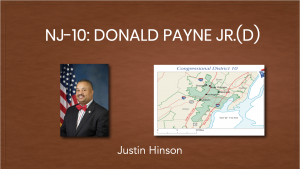
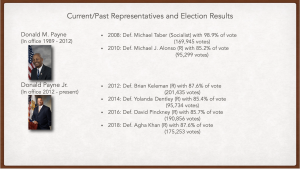
This slide outlines the 2008-2018 election results for New Jersey’s 10th Congressional District. This features Donald M. Payne, who was the member of Congress from 1989 until he passed away in 2012, and his son Donald Payne Jr. who became his successor in 2012. In 2008 and 2010, Payne won the Congressional District race with 98.9% and 85.2% of the vote, respectively. From 2012 to 2018, Donald Payne Jr. won the election consistently receiving between 85% and 87% of the vote, a similar margin of victory to that of his father in 2010. This congressional district has historically been a predominantly blue region in New Jersey, and the election results illustrate landslide victories from both Payne and Payne Jr. that demonstrate the overwhelming Democratic support. This statistic can be reinforced by the fact that this Congressional District also has a majority Black/African-American population of over 50%, and African-Americans in general have been closely linked to the Democratic party.
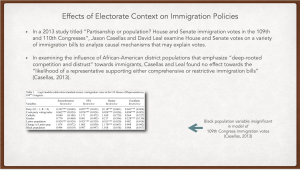
Slide 2 examines research discussing the effects of electorate context and district population demographics on voting towards certain types of immigration policies. In their study titled, “Partisanship or Population? House and Senate immigration votes in the 109th and 110th Congresses”, Jason Casellas and David Leal analyze the presence of certain causal mechanisms that may explain voting patterns on immigration policies. Casellas and Leal examined congressional voting on a variety of immigration bills, including restrictive and comprehensive bills. While competition between African-Americans and Latinos is theorized as a factor that can influence immigration-related policymaking, the authors concluded that there was no real evidence of economic competition existing between African-Americans and Latino, and it had no significant impact on voting decisions for immigration policy (Casellas, 2013).
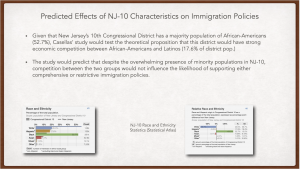
As a continuation from slide 2, this slide discusses the significance of Casellas’ study with regards to New Jersey’s 10th Congressional District. With a racial makeup of 52.7% of the population being African-American and 17.6% being Hispanic, this Congressional District can be examined as an example of the theory suggesting competition and tension between these two racial groups. However, following the Casellas study it can be predicted that these demographic makeup will not have an influence on whether immigration policy voting will be more restrictive or more comprehensive. I think that while the Casellas and Leal study provides evidence for the insignificance of certain demographic factors like racial competition, I think that it is worth examining the potential cultural tension that might exist in the specific region of New Jersey’s 10th Congressional District, which includes major cities such as Newark and Orange. This district has a 30% foreign-born population, half of which come from Latin America. With a strong Latino immigrant presence existing alongside a strong native African-American presence, the measure of how much influence these possible tensions might have can be put into question.
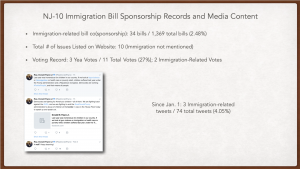
The last slide examines Donald Payne Jr.’s records of bill sponsorship and cosponsorship, in addition to his voting record on bills. While Payne Jr. has either sponsored or cosponsored 1,369 bills, only 34 of these bills were related to immigration. Payne has additionally voted on 2 immigration-related policies, voting in support of more funding directly tied to the Department of Homeland Security, of which he is a House committee member. Payne Jr.’s website illustrates the types of policies and issues he focuses on, and immigration not being an issue highlighted on his website supports how it isn’t viewed as a priority issue in the NJ-10 Congressional District, despite a higher foreign-born population compared to the New Jersey average. Payne Jr.’s tweet history also correlates with patterns of quietness regarding immigration, and only 3 of his 74 tweets since January include any mention of immigration or immigration-related issues.
